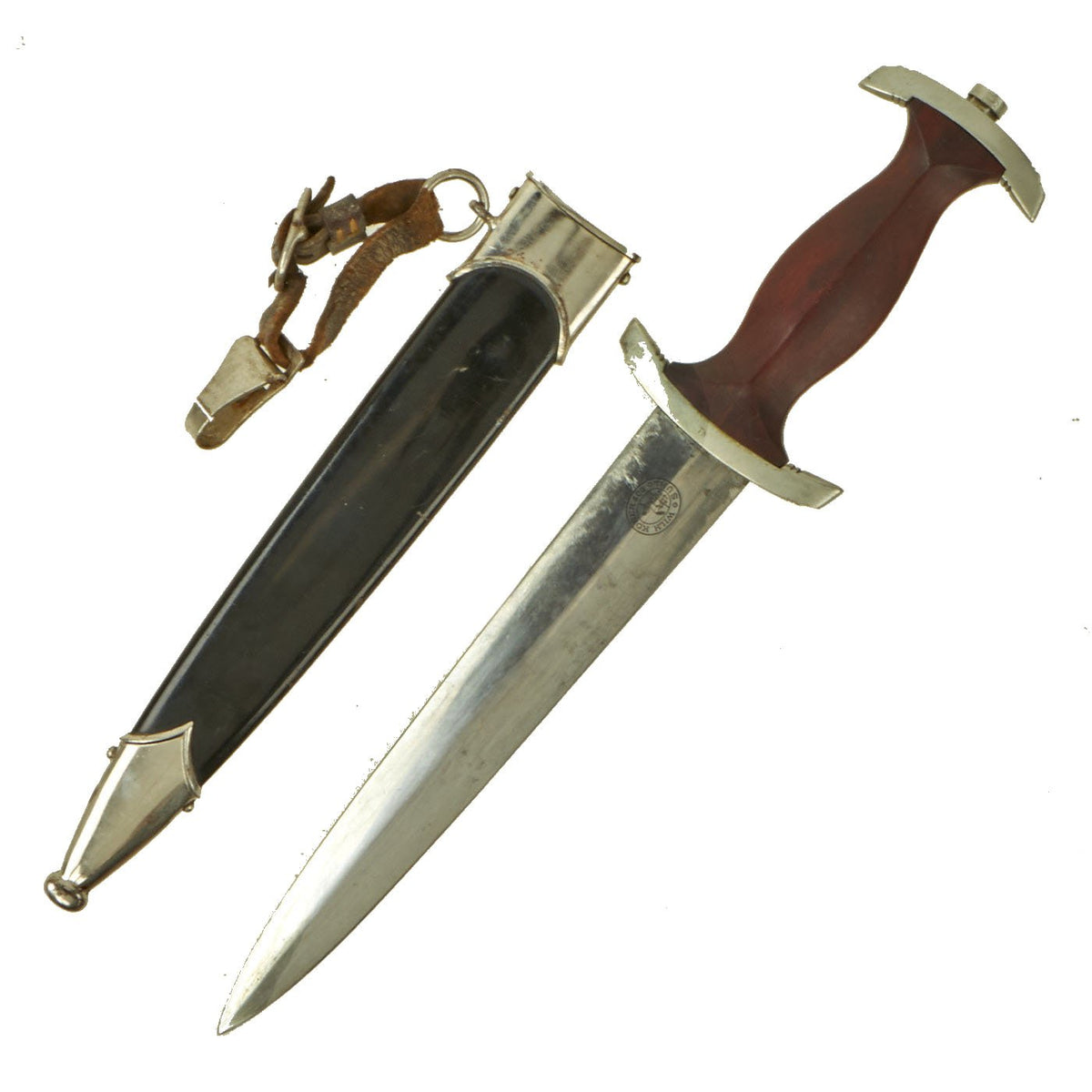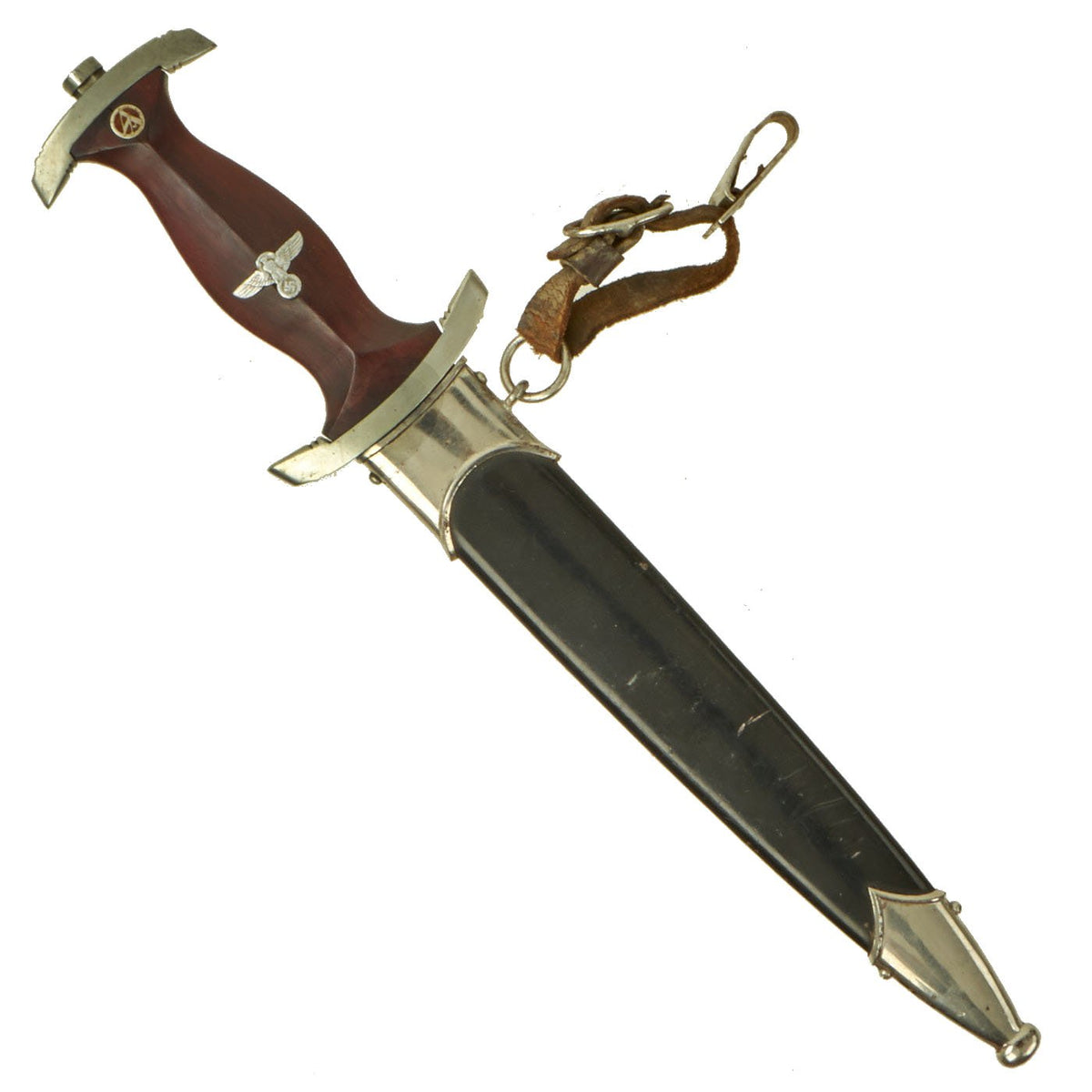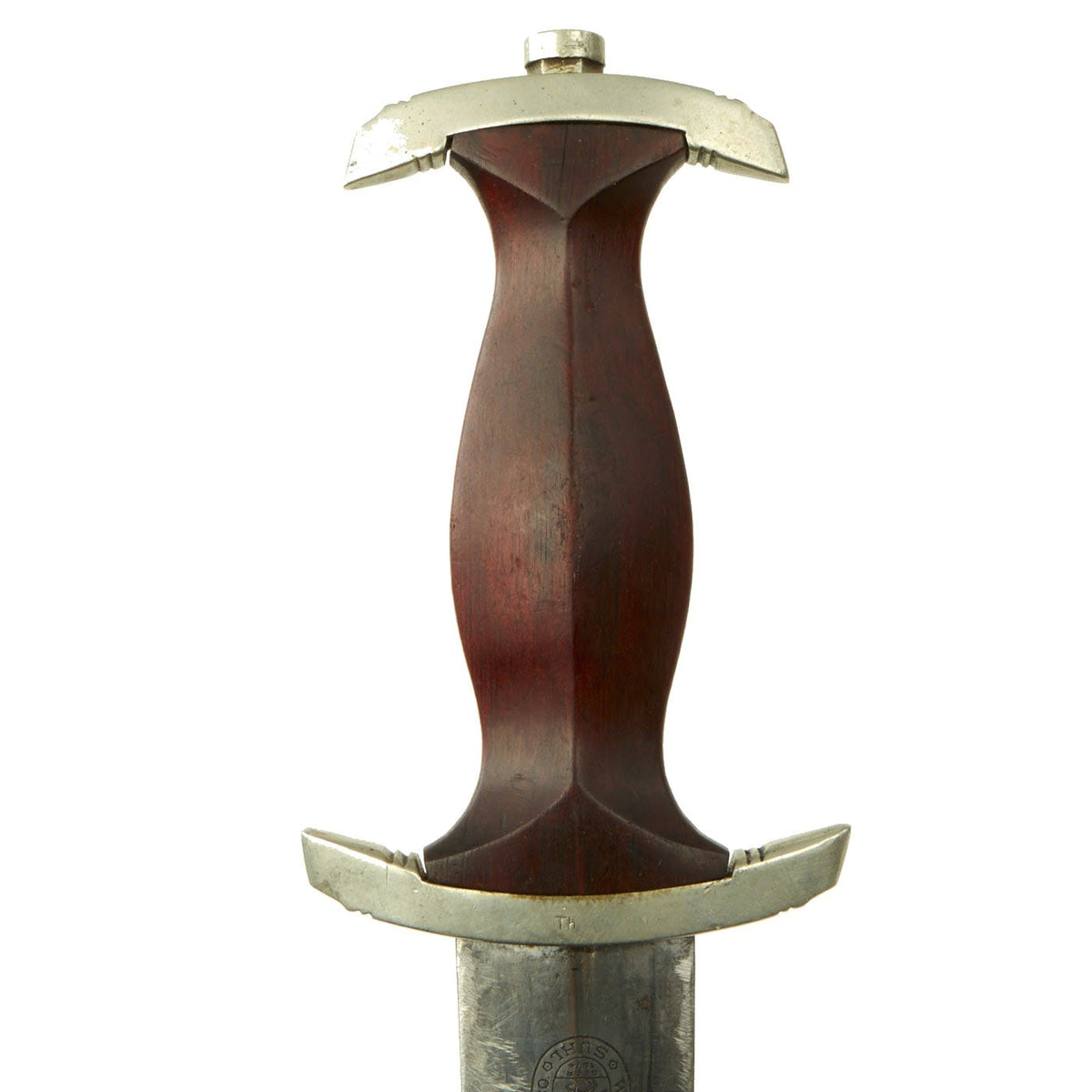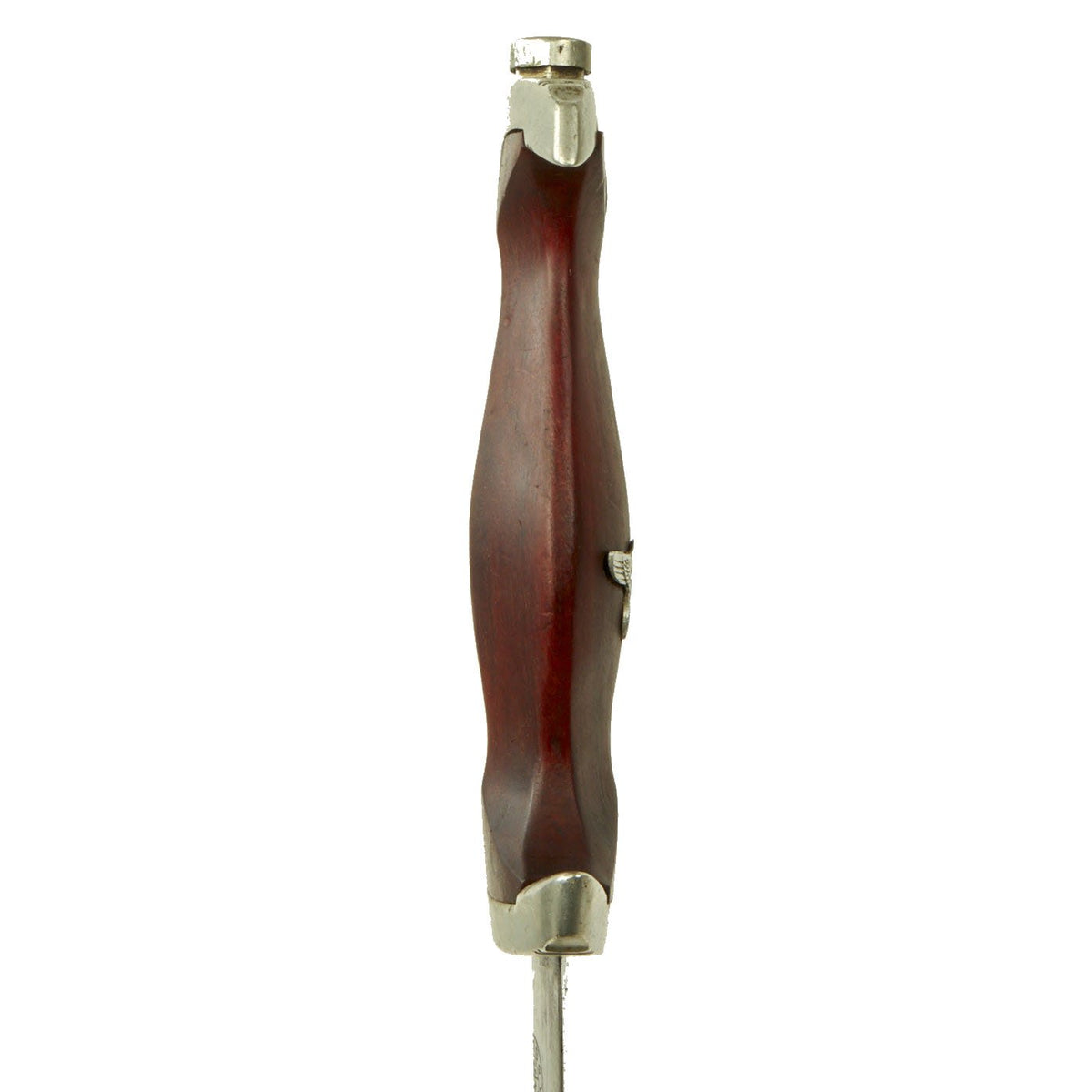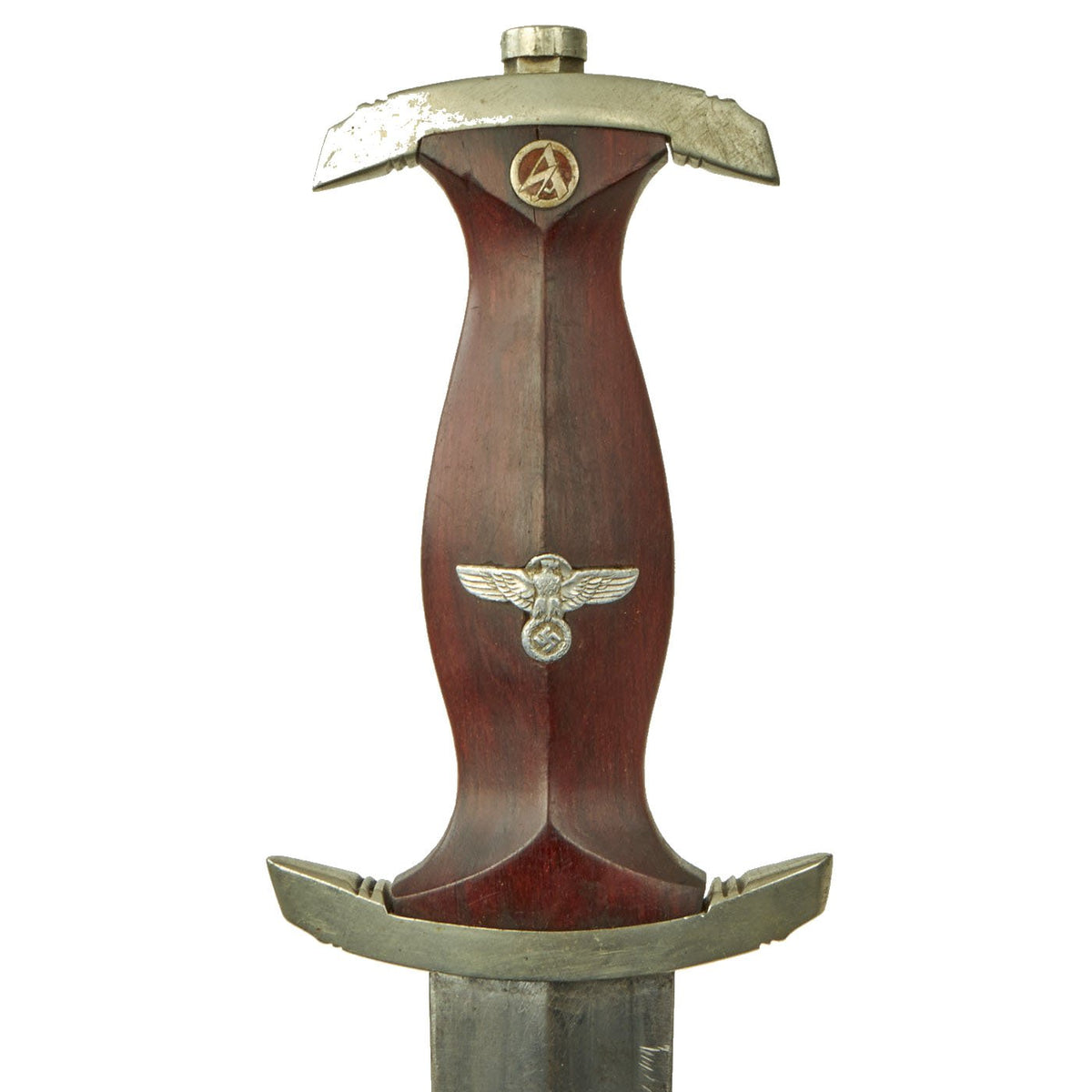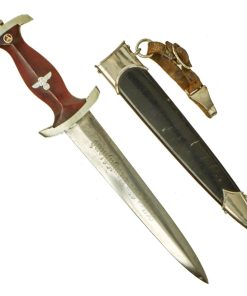Original German Early WWII NSKK Dagger by Rare Maker Wilhelm Kober with Scabbard & Hanger Original Items
$ 795,00 $ 238,50
Original Item: Only One Available. This is a very good condition early pattern NSKK Dagger, made by the very seldom seen firm of Wilhelm Kober & Co., based in Suhl, Germany. This maker is EXTREMELY rare to find, and this is only the second edged weapon of any type we have had by this firm. It comes comes compete with an original scabbard, which is in good shape, as well as an attached belt hanger.
The dagger has solid nickel silver fittings throughout, and is a nice example. The crossguards and tang nut are in very good condition throughout with all fittings having a nice lightly aged patina. There is a little age to these mounts but there is no lifting anywhere, showing that they are solid and not plated. They show very little wear or denting, if any, though the tang nut does look to have been tightened a bit without the proper tool. The lower reverse guard is Gruppe/Gau marked Th, for Thuringen (Thuringia), a district in central Germany, with the principal cities being Weimar and Erfurt.
The grip is a fine product having a nice red mahogany color, with medium center ridge construction, and just a bit of wear and a few small dents. This grip is in good condition and fits the crossguards nicely, with a crack between the pommel and the insignia. The symbol button is still nicely set, and still has most of the translucent enamel intact. The grip eagle is a fine example being the style with beak that points straight. The details are still there to the eagle to include the beak, breast feathering, wing feathering, talons, wreath and mobile swas (hook cross). The eagle is however loose in the grip, as the original glue has deteriorated. The nickel finish on both insignia is fully intact, with just a bit of oxidation.
This fine example was produced by Wilhelm Kober & Co., a known Suhl-based producer of this knife during the pre-WWII period. The rear of the dagger is marked with the trademark “Centaur with a fore-leg raised, brandishing a gun” logo, surrounded with a double oval:
WILH. KOBER & CO.
(Centaur Logo)
GEGR.
1874
SUHL
The “GEGR.” is short for Gegründet, or founded, as this company was founded in 1874, and according to the DRABS for 1900-1925 was mainly a maker of mechanical hair clippers. They made some attempts to diversify into small electric motors, and only “a few early type SA and NSKK daggers were made during the Third Reich” per J. Anthony Carter’s GERMAN KNIFE AND SWORD MAKERS. All of them were marked with this trademark, which was used specifically on these knives. Knives by this maker are extremely rare.
The blade is very good condition, though it does look to have been cleaned numerous times, and sharpened. The factory crossgrain is present but faint on both sides, and there are sighs of some past peppering, which was polished out. The acid-etched Alles für Deutschland (Everything for Germany) SA motto is slightly worn, and the original factory darkening is mostly worn away, though it is still present on the maker logo on the back. The blade is currently relatively dull, and these were never really meant to be used as weapons.
The scabbard shell is straight throughout and is the mid war production style, with a black enameled body and plated steel fittings. Most likely the original scabbard for the dagger was damaged or lost, and replaced during wartime with the current production. It is also possible that the owner was part of the NSKK before the split, and got a new scabbard rather than painting the original one. It is in very good condition, with just a few dents, and the plating and enamel retained very well. The fittings still have their original screws intact, and the hanger ring is in great shape.
The attached leather belt hanger unfortunately is quite worn, with the leather being suite dried and cracked. It is almost torn through around the hanger ring. It features nickel-plated steel fittings, typical for mid to late war production. The spring clip bears RZM code M5/71 over OLC in a diamond, the mark of Overhoff & Cie. of Lüdenscheid, a city with a large garment accessory and part industry.
The Reichszeugmeisterei, or RZM, was was based at the Brown house in Munich and NSDAP party headquarters in Berlin. The RZM ensured that the manufacturers of military items were consistent in design, quality of materials and other characteristics of the items. It also defined standards of design, manufacturing and quality and published an authoritative color chart for textiles. The M7 in the code stands for “uniform accessories”, contractor 71 stands for firm Overhoff & Cie. of Lüdenscheid.
An very nice early war NSKK dagger from a very rare maker, with an original scabbard and hanger. Ready to display!
Specifications:
Blade Length: 8 3/4″
Overall length: 13 3/4”
Crossguard: 3”
Scabbard Length: 10”
History of the SA-
The SA or Brown Shirts, were a private political formation which Adolf AH and the NSDAP used to maintain order at organized Party meetings and demonstrations. The group was formed in 1921, and grew to a huge force of nearly 3,000,000 men by the later 1930’s. To instill esprit de corps, as well as create employment for the Blade City of Solingen, it was decided each SA man would carry a dagger with his Brown Shirt uniform. Huge quantities needed to be produced to accommodate the demand. The dagger initially was produced of hand-fitted nickel mounts with attractive finished wood grip and brown anodized (a bluing process) finished scabbard.
The blade was etched with the SA motto, Alles für Deutschland. Examples produced prior to 1935 were stamped with the German sector of the SA group on reverse lower crossguard. Later examples underwent standardization through the RZM ministry. These pieces were produced of cheaper plated zinc-base fittings and scabbards were simply painted brown.
Prior to his “unmasking” as a traitor, Ernst Röhm was the leader of the SA. In 1934, he distributed approximately 100,000 SA daggers with his personal inscription on the reverse blade. These daggers were to honor individuals who had served with the SA prior to December, 1931. Other than the inscription, these pieces were identical to the standard M1933 SA dagger. After the Röhm purge, the inscription was ordered to be removed. Many examples were returned to the factory for grinding. Others were simply ground in the field by whatever means were available. Examples will occasionally be encountered with remnants of the original inscription remaining on the blade, but mostly none will remain. Some blades exist with an intact inscription, reflecting only the removal of the Röhm signature. Very very rarely is an example seen with a full, untouched inscription, as the holder would have surely risked a charge of treason.
After the purge, the NSKK, which had been a part of the SA, was split off into a separate organization. They retained the same daggers as the SA, however now used a black painted scabbard, and their officer’s daggers had a few differences as well. Many already had SA daggers, so these had the scabbards painted black over the original brown anodized finish.
Fast Shipping with Professional Packaging
Thanks to our longstanding association with UPS FedEx DHL, and other major international carriers, we are able to provide a range of shipping options. Our warehouse staff is expertly trained and will wrap your products according to our exact and precise specifications. Prior to shipping, your goods will be thoroughly examined and securely secured. We ship to thousands clients each day across multiple countries. This shows how we're dedicated to be the largest retailer on the internet. Warehouses and distribution centres can be located throughout Europe as well as the USA.
Note: Orders with more than one item will be assigned a processing date depending on the item.
Before shipping before shipping, we'll conduct a thorough inspection of the items you have ordered. Today, the majority of orders will be delivered within 48 hours. The delivery time will be between 3-7 days.
Returns
The stock is dynamic and we cannot completely manage it because multiple stakeholders are involved, including our factory and warehouse. So the actual stock may alter at any time. It's possible that you may not receive your order once the order has been made.
Our policy is valid for a period of 30 days. If you don't receive the product within 30 days, we are not able to issue a refund or an exchange.
You can only return an item if it is unused and in the same state as the day you received it. You must have the item in its original packaging.
Related products
Uncategorized
Armoured Fighting Vehicles of the World: AFVs of World War One (Hardcover Book) New Made Items
Uncategorized
Uncategorized
Uncategorized
Australian WWII Owen MK1 Machine Carbine SMG Custom Fabricated Replica with Sling Original Items
Uncategorized
Uncategorized
Uncategorized
Uncategorized
Uncategorized
Uncategorized
Uncategorized
Uncategorized
Uncategorized
Uncategorized
Uncategorized
Uncategorized
Uncategorized

